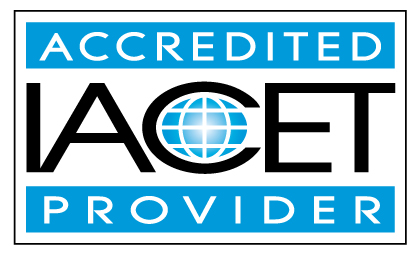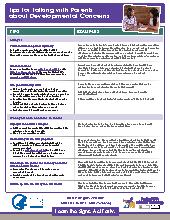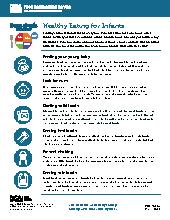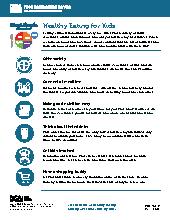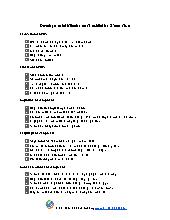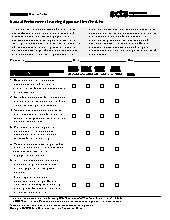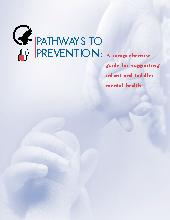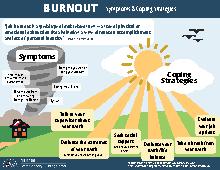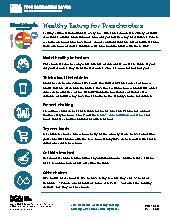Health & Safety Requirements for Childcare Providers
As part of the federal Child Care and Development Block Grant Fund stipulations, states must certify that there are health-and- #safety standards in place and training requirements that are appropriate to the provider setting and the age of the children served. Topics covered in this course include basic #health-and-safety requirements and best practices outlined in the CCDBG.
By the end of this training, the learner will be able to:
- Identify recommended medical and immunization schedules for children birth through age three
- Identify appropriate supervision practices for children during transportation and field trips.
- Demonstrate knowledge of exclusion criteria in a child care setting.
- Identify resources addressing health, safety and nutrition topics (CPR, 911, CDC, WIC, Poison Control)
- Identify practices for managing Illnesses, diseases, allergies, and medication in child care.
- Identify safety considerations for building, physical premises, and transportation and plan for emergency response.
- List which professions are mandated reporters.
- Describe infant/toddler nutritional needs.
- Demonstrate Understanding of Meal Planning for young children.
- Describe the components of emergency preparedness in the child care setting.
- Identify the signs of child abuse and neglect.
- Demonstrate an understanding of response planning for natural disasters and human-caused events
- Identify best practices when communicating with emergency personnel.
- Identify safe practices with infants including SIDS, Abusive Head Trauma, and SBS.
- Identify the nutritional needs of children aged four and above.
- List the steps to complete a report on abuse and neglect.
- Demonstrate an understanding of proper food storage and preparation.
- Identify strategies to assist children with food allergies/feeding concerns.
- Criteria to earn CEUs:
- Certificates are awarded when the following criteria have been met by the learner:
- Class has been paid in full
- All material has been reviewed
- All review questions and final test have been completed with a passing score of 80% or higher.
- Learning Assessment Method:
- Learners will be assessed through questions after every section is completed. Learners will not be
allowed to proceed to the next section of the training until all questions have been answered correctly.
Learners will be presented with a final test composed of true/false and multiple choice questions.
Upon successful completion of the training, learners will receive their certificate by email.
- Learning Methodology:
- Online material will be presented in the form of slides,
accompanied with speech. Videos will be used to demonstrate ideas and concepts. Charts and tables
will be used for illustration.
- Logistics/Required Technology:
- A stable internet connection is required for the completion of this course. Users are highly encouraged to take their online course on Google Chrome on either a laptop or desktop computer. Speakers and/or headphones are also required to hear speech.
- Payment Policy:
- Payments need to be made in full. No refunds will be issued after starting the class.
- Proprietary or conflict of interest disclosure:
- Unless otherwise stated in the course description none of H & H subject matter experts and editor has any conflict or proprietary interests related to the material they prepared in this course.
- Support Services:
- Please visit our contact us page
You are purchasing a session of an online training that includes online assessments. Your certificate will be emailed to you once you pass the final exam with a passing grade of 80%.
Your certificate will bear the name you provided to us when you signed up. For support and questions regarding the material presented in this class please contact us at info@childcareed.com. Please consult our frequently asked questions page for other questions or feel free to contact us.
No prerequisites are required for the completion of this course.
Hours breakdown
10 HSNTopics / Categories
Group AdminHealth and Safety
Not Applicable
Basic
Health, safety and nutrition
Latest Jobs
- Fulfilling Health and Safety Requirements for Child Care Providers with ChildCareEd
- Focus on Health and Safety Training
- How to Start a Daycare with Little Money
- How to Start a Daycare with the Right Qualifications
- How to Start a Daycare and Maintain Health and Safety
- Basic Health and Safety Training for Child Care Providers
- Basic Health and Safety Training: The Essential Guide for New Child Care
- Child Care Licensing in Texas: What You Need to Know to Stay Compliant
- Basic Health and Safety: The Must-Know Training for Childcare Professionals
- Basic Health and Safety in Childcare: A Complete Guide for Providers
- DCF Training Online: The Fast-Track to Meeting Childcare Requirements
- MSDE Basic Health and Safety: What Maryland Childcare Providers Need to Know
- Medical Administration Training for Childcare Staff: More Than Just a Requirement
- Legal Steps, SIDS Certification, and Safety Training in Daycare Made Easy
- Navigating the Maze of Child Care Licensing in Texas
- Demystifying the Online MSDE Basic Health and Safety Course
- 🩺Safe & Sound: Health and Safety Requirements Every Childcare Provider Must Know
- 📋🧸 What Do You Need to Work in Childcare in North Dakota?
- Understanding Childcare Licensing and Regulations in New York
- Understanding Childcare Licensing in Oklahoma

